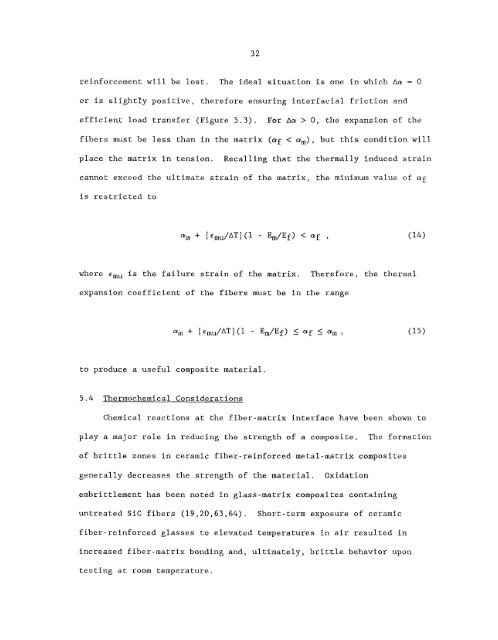Characterization and control of the fiber-matrix interface in ceramic ...
Characterization and control of the fiber-matrix interface in ceramic ...
Characterization and control of the fiber-matrix interface in ceramic ...
Create successful ePaper yourself
Turn your PDF publications into a flip-book with our unique Google optimized e-Paper software.
32<br />
re<strong>in</strong>forcement w Lll be lost. 'The ideal situation is one <strong>in</strong> which Aa = 0<br />
or is slightly positive, <strong>the</strong>refore ensur<strong>in</strong>g <strong>in</strong>terfacial friction <strong>and</strong><br />
efficient load transfer (Figure 5.3).<br />
For Aa > 0, <strong>the</strong> expansion <strong>of</strong> <strong>the</strong><br />
<strong>fiber</strong>s must be less than <strong>in</strong> <strong>the</strong> <strong>matrix</strong> (crf < a,), but this condition will<br />
place <strong>the</strong> <strong>matrix</strong> <strong>in</strong> tension. Recall<strong>in</strong>g that <strong>the</strong> <strong>the</strong>rmally <strong>in</strong>duced stra<strong>in</strong><br />
cannot exceed <strong>the</strong> ultimate stra<strong>in</strong> <strong>of</strong> <strong>the</strong> <strong>matrix</strong>, <strong>the</strong> m<strong>in</strong>imum value <strong>of</strong> af<br />
is restricted to<br />
where emu is <strong>the</strong> failure stra<strong>in</strong> <strong>of</strong> <strong>the</strong> <strong>matrix</strong>. Therefore, <strong>the</strong> <strong>the</strong>rmal<br />
expansion coefficient <strong>of</strong> <strong>the</strong> <strong>fiber</strong>s must be <strong>in</strong> <strong>the</strong> range<br />
to produce a useful Composite material.<br />
5.4 Thermochemical Considerations<br />
Chemical reactions at <strong>the</strong> <strong>fiber</strong>-<strong>matrix</strong> <strong><strong>in</strong>terface</strong> have been shown to<br />
play a major role <strong>in</strong> reduc<strong>in</strong>g <strong>the</strong> strength <strong>of</strong> a composite. The formation<br />
<strong>of</strong> brittle zones <strong>in</strong> <strong>ceramic</strong> <strong>fiber</strong>-re<strong>in</strong>forced metal-<strong>matrix</strong> composites<br />
generally decreases <strong>the</strong> strength <strong>of</strong> <strong>the</strong> material. Oxidation<br />
embrittlement has been noted <strong>in</strong> glass-<strong>matrix</strong> composites conta<strong>in</strong><strong>in</strong>g<br />
untreated Sic <strong>fiber</strong>s (19,20,63,64).<br />
Short-term exposure <strong>of</strong> <strong>ceramic</strong><br />
<strong>fiber</strong>-re<strong>in</strong>forced glasses to elevated temperatures <strong>in</strong> air resulted <strong>in</strong><br />
<strong>in</strong>creased <strong>fiber</strong>-<strong>matrix</strong> bond<strong>in</strong>g <strong>and</strong>, ultimately, brittle behavi-or upon<br />
test<strong>in</strong>g at room temperature.

















